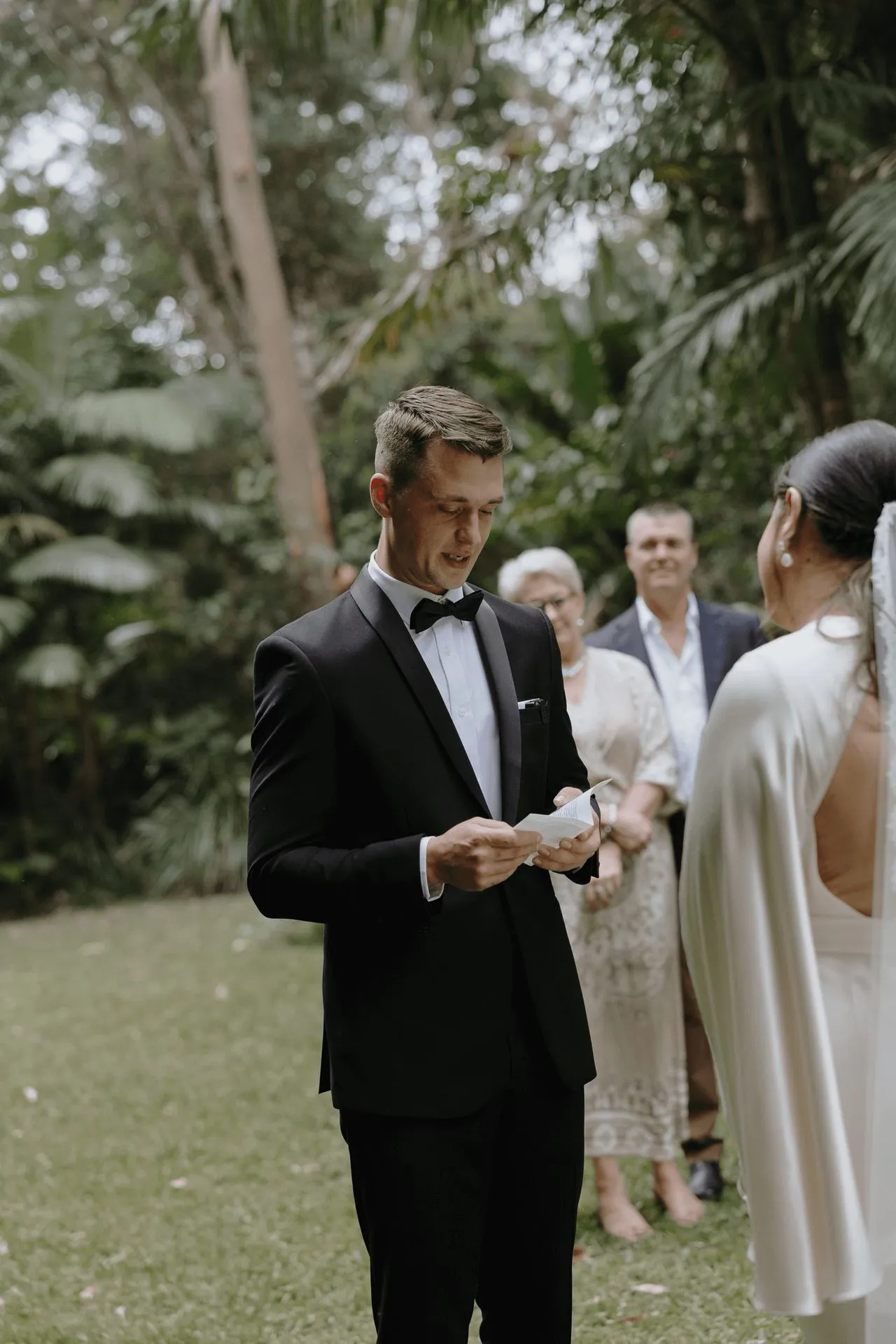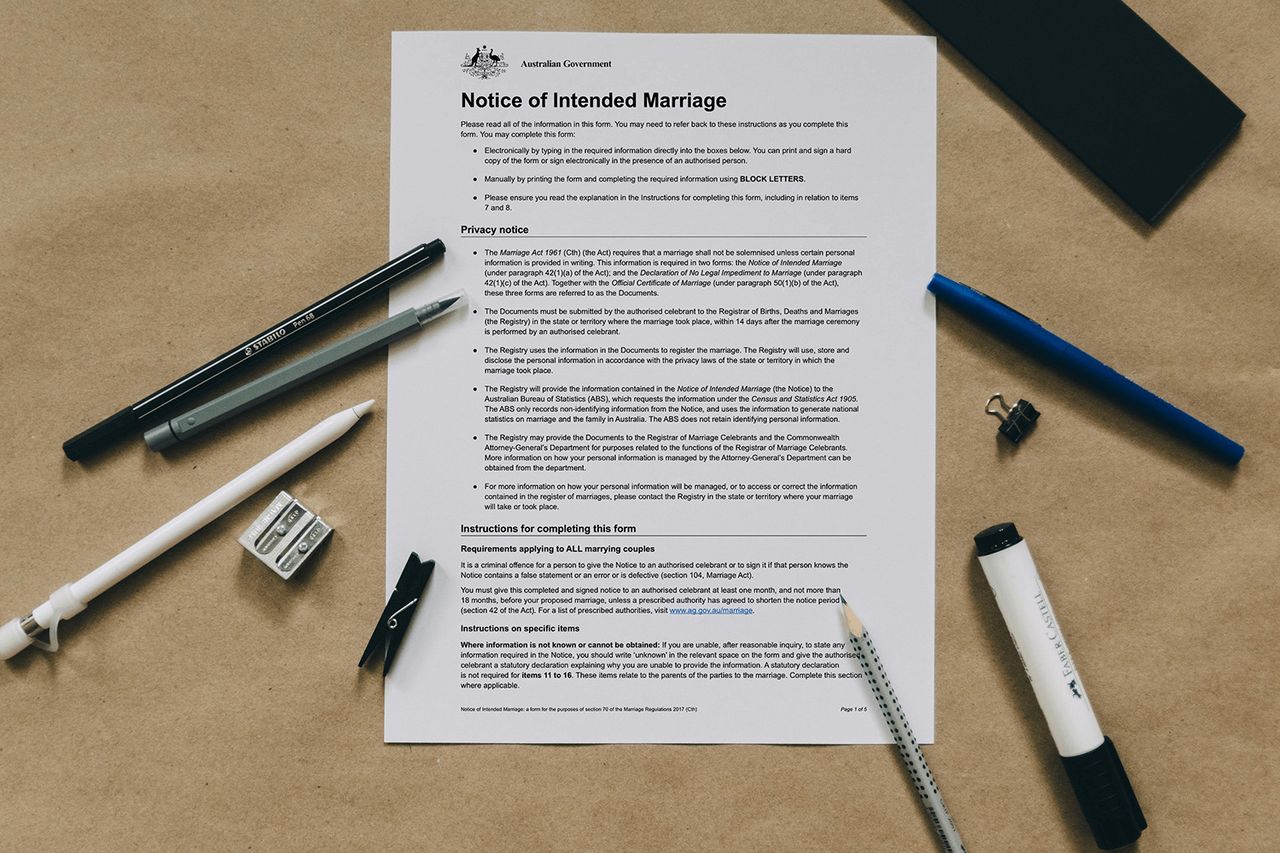· Marriage Laws · 6 min read
The bare minimum wedding vows in registry office
The legal essentials for Australian marriages - what you absolutely need for a valid wedding ceremony, from paperwork to vows, explained by Josh Withers.

Your wedding ceremony at a wedding venue, eloping, in a registry office, or over a cafe table, can be as long-winded, extravagant, special and ceremonial as you could ever desire.
Let your mind wander, start dreaming, and that 4-hour epic adventure of wedded love can be yours!
But many couples ask me as their wedding celebrant what the bare minimum is. “What is the shortest, simplest, easiest ceremony you can do?”
I don’t like to do bare minimum ceremonies, mainly because they are barely a ceremony, more of a procedure.
But there are legitimate reasons for doing bare minimum ceremonies. You might be getting married overseas, or in a more casual arrangement and would like to do the “legals” separately, perhaps before you leave for your South Pacific getaway. Or maybe you’re keeping the legal bit simple so you can have a more personalised celebration with family and friends later.
But whatever your reason, here are the bare minimum requirements to become married in Australia.

The paperwork before the wedding
A NOIM (Notice of Intended Marriage form) must be completed and witnessed by the people being married and a marriage celebrant, or another prescribed officer like a Justice of the Peace, Police Officer, or certain other authorised people. This form must be completed, with passports or birth certificates with drivers licences sighted, at least one month before the wedding day.
The one-month notice period is a legal requirement that gives authorities time to check there are no impediments to your marriage. It’s not just a suggestion – it’s a requirement under section 42 of the Marriage Act 1961.
Can the one month waiting period be waived?
The one-month notice can be waived by a prescribed authority (usually a magistrate or judge) in the following specific circumstances:
- Employment-related or other travel commitments: For example, if one of you has been suddenly deployed overseas
- Wedding or celebration arrangements, or religious considerations: Perhaps a terminally ill relative wants to attend but won’t be able to wait a month
- Medical reasons: Such as a terminal illness of one of the partners
- Legal proceedings: Including immigration issues that require immediate marriage
- Error in giving notice: If a celebrant made a mistake with your paperwork
But let me be clear – this doesn’t happen often. You really need to bring a compelling case to the authorities as to why you need a shortening of time. It’s not as simple as “we’re in a hurry” or “we forgot to plan ahead.” The prescribed authority will want to see evidence of your case.
The declaration
Just before the wedding ceremony, each party to the marriage must make a declaration before the authorised celebrant as to their conjugal status and belief that there is no legal impediment to the marriage. This Declaration of No Legal Impediment to Marriage is a legal requirement and confirms that:
- You’re both free to marry (not already married to someone else)
- You’re not in a prohibited relationship (closely related)
- You’re both of marriageable age
- You both consent to the marriage
This declaration can happen “before” the ceremony – seconds before, earlier in the day, or close to the date – but it must be completed before the marriage ceremony takes place.
On the wedding day itself
Once at least one month has passed since lodging your NOIM, on your wedding day, the absolute bare minimum ceremony must include:
Celebrant introduction: I must identify myself and my authority to conduct marriages in Australia.
The monitum: I must state to the people being married, in the presence of at least two witnesses over 18 years of age:
“I am duly authorised by law to solemnise marriages according to law. Before you are joined in marriage in my presence and in the presence of these witnesses, I am to remind you of the solemn and binding nature of the relationship into which you are now about to enter. Marriage, according to law in Australia, is the union of two people to the exclusion of all others, voluntarily entered into for life.”
Legal vows: Each partner must say to the other:
“I call upon the persons here present to witness that I, [full name], take thee, [full name], to be my lawful wedded wife/husband/spouse.”
You can add words before or after this statement, but these specific words (or words to similar effect that clearly express consent) must be included.
Signing the certificates: Three documents must be signed by the couple, two witnesses, and myself:
- Form 15: Certificate of marriage given to the couple (your official marriage certificate)
- Official Certificate of Marriage for the Registry of Births, Deaths and Marriages
- Register of Marriage Certificates kept by me as the celebrant
And now you’re legally married! That’s it. A legal marriage ceremony can be completed in under five minutes.
Everything else is optional (but wonderful)
Everything beyond these core elements is completely up to you:
- Exchanging rings
- Personal vows
- Readings or music
- Wedding party participation
- Symbolic rituals like handfasting or sand ceremonies
- Processional and recessional
- Wedding reception
I always remind couples that while the legal bits are important, they’re just the scaffolding that holds up the beautiful structure of your ceremony. The personal elements you choose to include are what make your wedding memorable and meaningful.
Why I encourage more than the minimum
While I can (and occasionally do) perform bare minimum ceremonies, I believe your wedding deserves more. The ceremony is the heart of your wedding day – it’s the moment you actually become married. When a couple chooses me as their celebrant, I encourage them to think about how they want that moment to feel.
A thoughtfully crafted ceremony becomes the foundation stone of your marriage. It creates a memory that you’ll carry with you through the years, and it gives your guests insight into your relationship and the commitment you’re making.
That said, I completely understand that sometimes the bare minimum is what works best for your situation. Whether you’re planning an elaborate celebration later, dealing with time constraints, or simply prefer a more intimate legal proceeding, I’m here to help make your wedding legal, meaningful, and stress-free.
If you’re curious about what a more personalised ceremony might look like, or you’d like to chat about your specific needs for a bare minimum ceremony, please don’t hesitate to get in touch.



